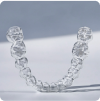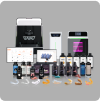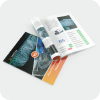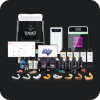Dental 3D Printer Performance Comparison & Buyer’s Guide
In the realm of digital orthodontics, selecting a high-performance 3D printer that matches clinical needs is essential for achieving efficient, precise treatment and same-day delivery workflows. For dental practices and orthodontic laboratories, comprehensive evaluation across dimensions such as print accuracy, speed, material compatibility, production capacity, and total cost of ownership is necessary to identify the most suitable equipment for their operational scale and clinical scenarios. This article provides an in-depth comparison of mainstream orthodontic 3D printers based on these core parameters, with a focus on the LuxCreo iLux Pro Dental Printer—an industry-leading direct-print clear aligner solution.
Why Choose Direct-Print Orthodontic Aligners?
Traditional thermoformed aligner production is cumbersome: it requires printing dental models first, then vacuum-forming plastic sheets over the model, followed by manual trimming and polishing. This wasteful and laborious process not only takes weeks, especially if outsourcing, but also suffers from inherent defects including uneven thickness, irreversible material creep, and rapid force decay, often necessitating multiple refinements that extend treatment timelines.
Direct 3D printing technology completely transforms this paradigm. Bypassing the need for intermediate models, it leverages biocompatible photopolymer resins to build aligners layer-by-layer, enabling a fully digital, closed-loop workflow from scan and design to print and post-processing to delivery. Production cycles shrink from weeks to 2hours, supporting same-day treatment initiation. More importantly, direct printing enables precise control over variable thickness design and localized force zones, delivering 80% higher transparency and 99% dimensional accuracy compared to thermoforming, while dramatically reducing manual polishing time (by 75%) and eliminating model storage and plastic waste.
Five Core Criteria for Evaluating Orthodontic 3D Printers
1. Print Accuracy & Dimensional Consistency
Clinical-grade orthodontic applications demand sub-100 micron precision to ensure perfect aligner-to-tooth fit, preventing force deviation that could lead to unintended tooth movement.
The LuxCreo iLux Pro Dental Printer is equipped with a 4K DLP optical engine (3840×2160 ppi, 50 µm pixel pitch), combined with LEAP™ (Light Enabled Additive Production) technology and 385 nm wavelength, achieving 99% dimensional accuracy. Direct-printed aligners exhibit thickness uniformity far superior to thermoforming (the latter can vary from 0.38-0.69 mm, while direct printing controls thickness to within design value ±0.1 mm).
In comparison, SprintRay and Formlabs can only print dental models—not aligners directly. They require a separate thermoforming process to create aligners, involving multiple manual steps that increase production time, labor costs, and complexity significantly.
2. Print Speed & Batch Production Capacity
High-speed printing and batch parallel production capabilities directly impact laboratory throughput and practice same-day delivery commitments.
The iLux Pro Dental features a build volume of 192×108×200 mm, capable of printing up to 12 80 clear aligners in a single batch. Paired with LuxFlow software’s intelligent nesting algorithms, it can mix aligners, dental models, splints, and other applications in the same build, maximizing space utilization. While speed is “material-dependent,” the LEAP™ technology’s low peel-force design delivers actual production speeds significantly superior to traditional SLA/SLS systems (which require over 20 hours for equivalent output).
The SprintRay Pro 2 can print 8 flat arches in 30 minutes. DLP technology makes layer curing independent of surface area, faster than laser SLA (like Formlabs Form 3B), but its smaller build platform limits batch processing capacity compared to iLux Pro dental printer. While the Formlabs Form 4B matches Pro 2’s print speed (100 mm/h), its build volume (20×12.5×21 cm) is 27% larger than iLux Pro, allowing 11 aligner models or 8 splints per batch with theoretically higher capacity.
The UNIZ NBEE, touted as the “speed king,” employs UDP (Ultra-fast Digital Printing) technology, printing 6 full-arch models in just 8 minutes, but primarily targets high-volume laboratories and doesn’t support direct aligner printing.
Multi-material support and an open resin ecosystem are critical for assessing equipment flexibility.
The iLux Pro Dental Printer supports over 23 dental resins, including LuxCreo’s proprietary DCA (Dental Clear Aligner resin), DMR III (Dental Model Resin), DNG (Night Guard Resin), DSG (Surgical Guide Resin), plus third-party materials from KeySplint Soft, Glidewell, Dreve, Rodin, Flexcera, and others. It covers 11+ dental applications (aligners, retainers, splints, models, surgical guides, denture bases, crowns, etc.). The DCA resin has achieved FDA Class II 510(k) and CE IIA certifications, passing the complete ISO 10993 biocompatibility test suite (cytotoxicity, oral mucosal irritation, skin sensitization, genotoxicity, acute/subchronic systemic toxicity, subcutaneous implantation, etc.).
The SprintRay Pro series offers an extensive resin library, though primarily closed-source or partnered materials; Formlabs Form 3B/4B strictly limits users to official resins, lacking third-party compatibility. Asiga Max 2 is renowned for its open material platform, supporting over 500 validated resin profiles covering casting, denture bases, surgical guides, and more—ideal for laboratories requiring maximum material flexibility.
4. Workflow Integration & Automation
End-to-end digital workflows and AI-driven automation from scan to delivery can dramatically reduce labor costs and operational barriers.
The LuxCreo ecosystem achieves seamless integration through “1-Click AI Automation”:
- LuxDesignSoftware: Automatically repairs STL files, generates block-outs, creates trimlines, and sets variable thickness zones (e.g., 0.5 mm for anterior teeth, 0.8 mm for molars) without manual adjustment, generating aligner shells with one click.
- LuxFlow Print Preparation Software: Intelligent model orientation, automatic support generation, high-speed slicing, batch processing of multiple cases, direct transmission to iLux Pro without file format conversion.
- Digital Polishing™: Prints emerge with glass-like transparency requiring no manual polishing, delivering 80% higher clarity and reducing polishing time by 75%.
- Automated Post-Processing: iLuxWash Dental (magnetic stirring + ultrasonic + heated cleaning) and iLuxCure Pro (360° bidirectional UV curing + 60°C thermal curing) standardize washing and curing processes, ensuring stable mechanical performance and biocompatibility.
Active labor time per aligner is only 1.5 minutes, compared to 5.5 minutes for traditional thermoforming, representing a 3X productivity boost (enabling the same team to achieve 3X revenue growth).
The SprintRay Pro 2 comes with ProWash and ProCure systems, offering cloud-based software platforms and AI design service integration, but lacks LuxCreo-level full automation for aligner shell design. The Formlabs Form 4B includes automatic resin dispensing and Build Platform 2 quick-release features, but resin cartridge costs remain high (though 40% lower than SprintRay), and it doesn’t support direct aligner printing.
5. Total Cost of Ownership (TCO) & Return on Investment (ROI)
Beyond equipment purchase price, factors including consumables, maintenance, labor, and capacity collectively determine long-term costs.
Cost Comparison (Per Aligner):
| Item | Chairside Direct Printing (LuxCreo) | Chairside Thermoforming |
| Labor/Service Cost | $2.72 | $3.90 |
| Material Cost | $4.67 | $6.92 |
| Software Cost | $5.00 | $5.00 |
| Failure Loss | $0.08 | $0.05 |
| Total Cost | $12.47 | $15.87 |
| Cost Reduction | 19% | — |
Data Source: Dr. Bill Layman practice case study
The iLux Pro Dental Solution is priced at approximately $25,000, including the printer, software (LuxDesign + LuxFlow), 12-month warranty, and technical support; complementary post-processing equipment iLuxWash and iLuxCure Pro total approximately $5,000-6,000. In contrast, the SprintRay Pro 2 complete package (printer, post-processing, service plan) approaches $18,000; the Formlabs Form 4B complete package ranges from $7,899-9,227, but is limited to printing models and doesn’t support direct aligner printing.
ROI Accelerators:
- Same-Day Delivery Boosts Patient Conversion: Delivering aligners 2 hours post-scan dramatically shortens wait times, improving case acceptance and satisfaction.
- Diversified Revenue Streams: The same device can produce retainers, night guards, bite splints, surgical guides, and models, amortizing equipment costs.
- Reduced Outsourcing Dependency: Saving $3.40 per aligner, processing 100 cases monthly saves $40,000+ annually.
LuxCreo iLux Pro Dental: Industry Benchmark for Direct-Print Aligners
Core Technical Advantages
- World’s First FDA Class II 510(k)-Cleared Direct-Print Aligner System: LuxCreo pioneered FDA clearance in 2022, inaugurating the direct-print aligner era.
- ActiveMemory™ Shape-Memory Polymer:
- Thermoreversible Recovery: Immersion in >60°C hot water fully restores the aligner’s original geometry (deviation <0.1 mm) and force profile, equivalent to “wearing a fresh aligner every day.”
- Stable Intraoral Force: Elastic modulus varies <10% between 25°C-37°C, avoiding creep failure of traditional thermoplastics or thermoactivation of direct-printed material at body temperature.
- Dual-Mechanism Design: Hard segments maintain intraoral thermomechanical stability while soft segments permit reversible deformation, solving the fatal flaw of conventional thermoset shape-memory polymers (SMPs) whose modulus drops >70% at 37°C.
- Variable Thickness Precision Control:
- Through AI algorithms, thickness is regionally defined during the design phase (e.g., 0.5 mm for incisors for gentle pressure, 0.7 mm for canines for enhanced torque, 0.6 mm for molars for anchorage control), achieving directional force application and reduced attachment dependency (some cases completed with zero attachments).
- Digital Polishing™:
- Prints emerge with glass-like transparency without manual polishing, 80% higher clarity than competitors, reducing polishing time by 75%.
- 99% Print Success Rate:
- LEAP™ technology’s low peel force and real-time temperature control ensure consistent quality during continuous high-volume production.
Clinical & Operational Benefits
- Same-Day Treatment Initiation: From scan to delivery in just 2-3 hours, eliminating traditional outsourcing’s 2-4 week wait.
- Reduced Refinements: Stable force profiles lower mid-treatment correction frequency, shortening total treatment time.
- Enhanced Patient Comfort: ActiveMemory™’s balanced load-deflection behavior avoids excessive initial force and subsequent material relaxation.
- Sustainability: Digital storage of design files with on-demand printing eliminates model inventory and plastic waste.
- Practice Case Studies:
- Dr. Bill Layman: “With the benefit of hindsight, I wish I would have researched more on LuxCreo before I purchased SprintRay. I now own two LuxCreo machines.”
- Dr. Mike Pham: “LuxDesign software saves my practice 60-75% in labor costs compared to traditional workflows, and significantly shortens patient wait times.”
- Dr. Neil Warshawsky: “Variable thickness aligners are the future of orthodontic aligner therapy—it’s the ‘holy grail,’ and LuxCreo invented it. 4D Aligner provides superior fit accuracy unmatched by thermoforming, better torque control, and requires fewer tooth attachments.”
Equipment Specifications Summary
| Specification | iLux Pro Dental |
| Build Volume | 192×108×200 mm |
| Resolution | 3840×2160 ppi, 50 µm pixel pitch |
| Light Source | 385 nm DLP |
| Batch Capacity | Up to 80 aligners |
| Dimensional Accuracy | 99% |
| Material Support | 23+ dental resins (DCA, DMR III, DNG, DSG, etc.) |
| Application Range | 11+ (aligners, retainers, splints, models, guides, dentures, etc.) |
| Software Ecosystem | LuxDesign (1-Click AI Design) + LuxFlow (Smart Slicing) |
| Network Connectivity | USB / Ethernet / WiFi |
| Certifications | FCC, CE, UL; DCA resin FDA Class II 510(k), CE IIA |
| Warranty | 12 months (extendable) |
Comparison with Mainstream Competitors
| Feature | LuxCreo iLux Pro Dental | SprintRay Pro 2 | Formlabs Form 4B | Asiga Max 2 |
| Print Technology | DLP (LEAP™) | DLP (Optical Panel™) | MSLA (LFD™) | DLP |
| Build Volume | 192×108×200 mm | 18.8×10.5×20 cm | 20×12.5×21 cm (27% larger) | Large-format platform |
| Resolution | 50 µm, 4K | High resolution | 25 µm XY, 25-200 µm Z | Industry-leading |
| Print Speed | Material-dependent, fast | Theoretical 100 mm/h (with Arch Kit) | 100 mm/h, 11 models/9 min | Medium |
| Batch Capacity | 80 aligners | 6 full-arch models | 11 aligner models/8 splints | Multi-application batch |
| Direct Aligner Printing | ✅ (FDA-cleared DCA resin) | ❌ (models only, then thermoform) | ❌ (models only, then thermoform) | ❌ |
| Material Compatibility | Open ecosystem (23+ types) | Primarily closed | Strictly closed | Super-open (500+) |
| Shape-Memory Material | ✅ ActiveMemory™ | ❌ | ❌ | ❌ |
| Variable Thickness Design | ✅ AI auto-generation | ❌ | ❌ | ❌ |
| Digital Polishing | ✅ (80% higher clarity) | ❌ | ❌ | ✅ Ultra Gloss |
| 1-Click Automation | ✅ (LuxDesign+LuxFlow) | Partial automation | Auto resin dispensing | Manual configuration needed |
| Complete Package Price | ~$15,000-17,000 | ~$18,000 | ~$7,899-9,227 | $10,000-15,000 |
| Cost Per Aligner | $12.47 | ~$15.87 (thermoform) | ~$15.87 (thermoform) | N/A |
| Best Application | Direct-print aligners/retainers/splints, same-day delivery | Chairside models + thermoformed aligners | Chairside models + restorations | Lab high-precision multi-application |
Selection Guidelines & Best Practices
How to Choose the Right Orthodontic 3D Printer?
Prioritize Direct Printing vs. Model + Thermoforming:
For same-day delivery, reduced labor, and enhanced accuracy, choose systems supporting direct aligner printing (currently only LuxCreo iLux Pro is FDA-cleared).
Evaluate Capacity Needs:
Small practices/monthly cases <50: iLux Pro Dental (192×108 mm) or Formlabs Form 4B (20×12.5 cm).
High-volume labs/monthly cases >100: Lux 3D+ (LuxCreo industrial-grade printer, 4X faster than iLux Pro) or Asiga Ultra.
Material Ecosystem Openness:
For multi-brand resin flexibility, choose open platforms (iLux Pro supports 23+ types, Asiga supports 500+ types).
Prioritize end-to-end automation solutions (LuxCreo’s LuxDesign+LuxFlow+Digital Polishing).
Avoid systems requiring multiple software platforms and manual transfers.
Total Cost of Ownership:
Comprehensively consider equipment price, resin costs, labor efficiency, equipment lifespan, maintenance fees.
While iLux Pro’s initial investment is slightly higher than some competitors, its 19% lower per-unit cost, 75% labor reduction, and 99% print success rate, and 24/7 customer service team typically enable ROI payback within months.
Implementation Recommendations
- Practice Layout: iLux Pro + iLuxWash + iLuxCure require only 35×20 inches of desktop space, suitable for chairside or small backroom
- Team Training: LuxCreo provides a global technical support network and on-site training, with 99% of support requests responded to within 60 minutes.
- Case Selection: Start with mild-to-moderate crowding/spacing cases, then expand to complex movements (e.g., molar distalization, root torque) as experience builds.
- Quality Control: Follow validated printing and post-processing parameters to ensure biocompatibility and stable mechanical performance.
Conclusion
In orthodontic 3D printer purchasing decisions, LuxCreo iLux Pro Dental stands as the ideal choice for dental practices and orthodontic laboratories pursuing same-day delivery, high precision, and low cost, thanks to its world’s first FDA-cleared direct-print aligner system, ActiveMemory™ shape-memory material, variable thickness precision control, 1-Click AI automated workflow, Digital Polishing™ technology, and 99% print success rate.
Compared to traditional thermoforming workflows, direct printing technology shrinks production cycles from weeks to 2-3 hours, reduces per-aligner costs by 19%, cuts labor time by 75%, and boosts transparency by 80%, providing clinicians with unprecedented design freedom and treatment predictability. For scenarios still requiring model + thermoforming workflows, SprintRay Pro 2 and Formlabs Form 4B deliver excellent speed and accuracy, but cannot provide the disruptive advantages of direct aligner printing.
Looking ahead, as AI design optimization, gradient-stiffness materials, and remote monitoring platforms further mature, direct-print aligners will become the mainstream standard in orthodontics. LuxCreo is already leading this transformation, providing dental professionals worldwide with faster, smarter, and more exceptional digital solutions.
To learn more or schedule a demo, visit LuxCreo.com or call 1-650-336-0888.
Subscribe to Our Newsletter
Be the first to get our latest updates and free trials!
Popular Resources
Follow Us
Featured Products

4D Aligner™
First Smart ActiveMemory™
Aligner

iLux Pro Dental Solution
Ultimate 1-Click Dental
Application Solution

LuxCloud Dental
Your One-stop Digital Dentistry
Platform

 dental.luxcreo.com
dental.luxcreo.com






